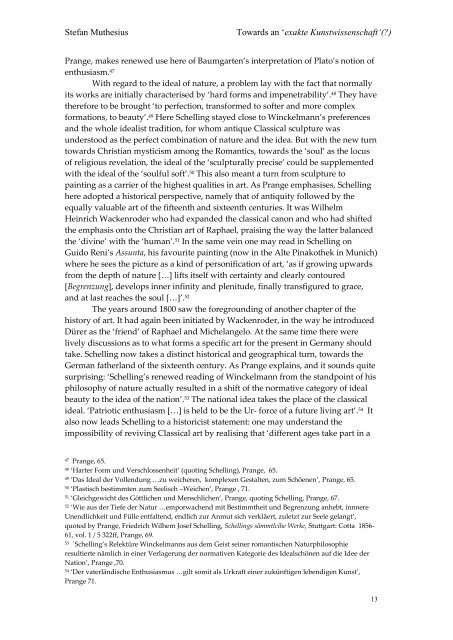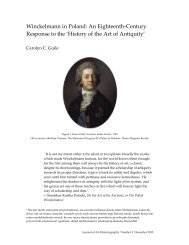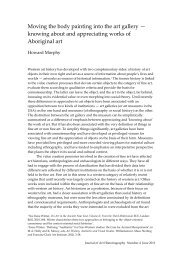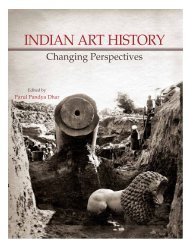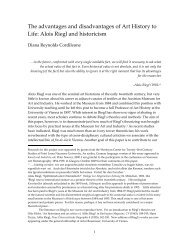9/SM1 - Journal of Art Historiography
9/SM1 - Journal of Art Historiography
9/SM1 - Journal of Art Historiography
Create successful ePaper yourself
Turn your PDF publications into a flip-book with our unique Google optimized e-Paper software.
Stefan Muthesius<br />
Towards an ‘exakte Kunstwissenschaft‘(?)<br />
Prange, makes renewed use here <strong>of</strong> Baumgarten’s interpretation <strong>of</strong> Plato’s notion <strong>of</strong><br />
enthusiasm. 47<br />
With regard to the ideal <strong>of</strong> nature, a problem lay with the fact that normally<br />
its works are initially characterised by ‘hard forms and impenetrability’. 48 They have<br />
therefore to be brought ‘to perfection, transformed to s<strong>of</strong>ter and more complex<br />
formations, to beauty’. 49 Here Schelling stayed close to Winckelmann’s preferences<br />
and the whole idealist tradition, for whom antique Classical sculpture was<br />
understood as the perfect combination <strong>of</strong> nature and the idea. But with the new turn<br />
towards Christian mysticism among the Romantics, towards the ‘soul’ as the locus<br />
<strong>of</strong> religious revelation, the ideal <strong>of</strong> the ‘sculpturally precise’ could be supplemented<br />
with the ideal <strong>of</strong> the ‘soulful s<strong>of</strong>t’. 50 This also meant a turn from sculpture to<br />
painting as a carrier <strong>of</strong> the highest qualities in art. As Prange emphasises, Schelling<br />
here adopted a historical perspective, namely that <strong>of</strong> antiquity followed by the<br />
equally valuable art <strong>of</strong> the fifteenth and sixteenth centuries. It was Wilhelm<br />
Heinrich Wackenroder who had expanded the classical canon and who had shifted<br />
the emphasis onto the Christian art <strong>of</strong> Raphael, praising the way the latter balanced<br />
the ‘divine’ with the ‘human’. 51 In the same vein one may read in Schelling on<br />
Guido Reni’s Assunta, his favourite painting (now in the Alte Pinakothek in Munich)<br />
where he sees the picture as a kind <strong>of</strong> personification <strong>of</strong> art, ‘as if growing upwards<br />
from the depth <strong>of</strong> nature […] lifts itself with certainty and clearly contoured<br />
[Begrenzung], develops inner infinity and plenitude, finally transfigured to grace,<br />
and at last reaches the soul […]’. 52<br />
The years around 1800 saw the foregrounding <strong>of</strong> another chapter <strong>of</strong> the<br />
history <strong>of</strong> art. It had again been initiated by Wackenroder, in the way he introduced<br />
Dürer as the ‘friend’ <strong>of</strong> Raphael and Michelangelo. At the same time there were<br />
lively discussions as to what forms a specific art for the present in Germany should<br />
take. Schelling now takes a distinct historical and geographical turn, towards the<br />
German fatherland <strong>of</strong> the sixteenth century. As Prange explains, and it sounds quite<br />
surprising: ‘Schelling’s renewed reading <strong>of</strong> Winckelmann from the standpoint <strong>of</strong> his<br />
philosophy <strong>of</strong> nature actually resulted in a shift <strong>of</strong> the normative category <strong>of</strong> ideal<br />
beauty to the idea <strong>of</strong> the nation’. 53 The national idea takes the place <strong>of</strong> the classical<br />
ideal. ‘Patriotic enthusiasm […] is held to be the Ur- force <strong>of</strong> a future living art’. 54 It<br />
also now leads Schelling to a historicist statement: one may understand the<br />
impossibility <strong>of</strong> reviving Classical art by realising that ‘different ages take part in a<br />
47<br />
Prange, 65.<br />
48<br />
‘Harter Form und Verschlossenheit’ (quoting Schelling), Prange, 65.<br />
49<br />
‘Das Ideal der Vollendung …zu weicheren, komplexen Gestalten, zum Schöenen’, Prange, 65.<br />
50<br />
‘Plastisch bestimmten zum Seelisch –Weichen’, Prange , 71.<br />
51<br />
‘Gleichgewicht des Göttlichen und Menschlichen’, Prange, quoting Schelling, Prange, 67.<br />
52<br />
‘Wie aus der Tiefe der Natur …emporwachend mit Bestimmtheit und Begrenzung anhebt, innnere<br />
Unendlichkeit und Fülle entfaltend, endlich zur Anmut sich verkläert, zuletzt zur Seele gelangt’,<br />
quoted by Prange, Friedrich Wilhem Josef Schelling, Schellings sämmtlcihe Werke, Stuttgart: Cotta 1856-<br />
61, vol. 1 / 5 322ff, Prange, 69.<br />
53<br />
`Schelling’s Relektüre Winckelmanns aus dem Geist seiner romantischen Naturphilosophie<br />
resultierte nämlich in einer Verlagerung der normativen Kategorie des Idealschönen auf die Idee der<br />
Nation’, Prange ,70.<br />
54<br />
‘Der vaterländische Enthusiasmus …gilt somit als Urkraft einer zukünftigen lebendigen Kunst’,<br />
Prange 71.<br />
13


